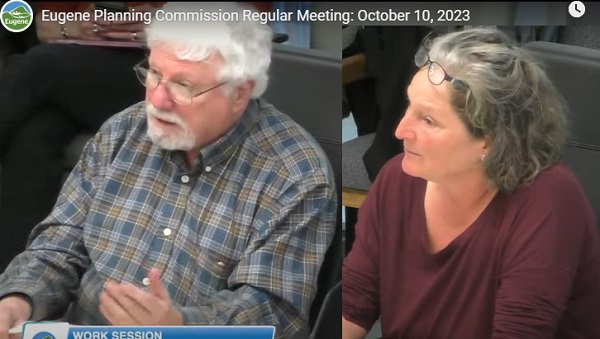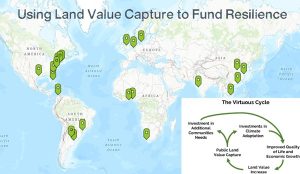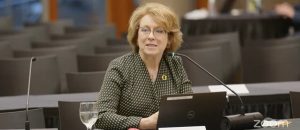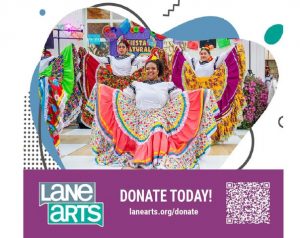‘Whittled back’ River Road-Santa Clara plan moves toward adoption
10 min read
Since two of Eugene’s biggest neighborhoods started a joint planning effort six years ago, the world has changed. With their plan moving towards possible adoption next month, River Road and Santa Clara shared three big concerns. At the planning commission Oct. 10:
Kate Perle (Santa Clara): I’m Kate Perle. I’m the chair of the Santa Clara Community Organization, and I’ve been co-chair of the community advisory committee to the neighborhood plan since its inception in 2017. And there has been—whoa, I can’t even—I don’t even have the words to describe how much community work has gone into this.
[00:00:36] Our community organization is excited to move on to implementation after six years of working on this and feeling thwarted, in part, by global events and state mandates and changes in the landscape of implementation and, drastically changing what some of our hopes and abilities are to affect the change that our neighbors clearly articulated.
[00:01:01] And, I guess the one aspect of it (and I think Jon will reiterate this too) that has gotten left behind is the work that was done on the River Road corridor plan, which was really about transit-oriented design between the Chambers (Street) connector and the Hunsaker transit station—LTD’s transit station.
And there was an inordinate amount of work done by our communities, our two neighborhoods, to build consensus around ways forward to accommodate densification, to accommodate wishes to keep our neighborhood character and unique qualities, and still help promote local businesses and create an active and walkable corridor.
[00:01:43] There’s so much really great material in that study and think there’s a general feeling of unease about what the future brings for that level of specificity, which we had hoped to gain from this neighborhood plan. And the new way forward is, the city has expressed interest in creating citywide corridor codes.
[00:02:04] And after doing the work, we did it on our particular corridor. We’re really clear that there isn’t one code that’s going to satisfy all the corridors equally and that there needs to be corridor-specific code language for each of those codes, in addition to whatever the baseline uniform code might be.
[00:02:23] And so I would be remiss if I didn’t just encourage that going forward, in creating citywide corridor code, that all the work that was done doesn’t get left behind; that there’s so much great technical and fine-grained detail about implementing the neighborhoods’ hopes and desires for creating a community of the future; that I can’t exact a promise (I don’t think), but that would be our hope.
[00:02:54] Jon Belcher (River Road Community Organization): I’m Jon Belcher and I am co-chair of my neighborhood association and co-chair of the CAC (community advisory committee) as well. I’d like to talk to you about the specific recommendation from our neighborhood association. We did unanimously agree to vote to move forward the plan as it exists. But we do have three core areas of concern that did not get resolved in the planning process, that we feel really need to be resolved that this plan is going to be a positive one from the neighborhood rather than a negative one.
[00:03:25] The first is: There’s no parking resolution for our county streets. You may or may not be aware, but 76% of the River Road streets and 58% of Santa Clara streets are not city streets. They’re county streets. They’re under the jurisdiction of the county. They’ve been developed to rural standards, not city standards—no curbs and gutters, no clear demarcation of where the right of way begins and ends.
[00:03:51] And that creates a challenge when all of a sudden you get a significant increase in the number of people wanting to park on-street. This is what we learned when Ecco Apartments came into the neighborhood. It was our first large development, 192 units. They met the minimal parking standards for a corridor development.
[00:04:12] And all of a sudden what we noticed was, is that partially because of that low density of parking, and partially because the property management charged for half of those parking spaces, people decided they’d rather park in the neighborhood. That normally would be fine in the city area because you have parking standards and parking enforcement.
[00:04:32] We don’t have that because the county has a weighmaster who basically spends his time removing abandoned cars. And as far as I know, there are not even ordinances in the county that would control that type of behavior.
[00:04:46] So back in 2019 (I don’t know how many of you were on the planning commission then), the city requested with us that the city annex the right of ways of the streets that surrounded Ecco Apartments, so we could enforce some kind of a parking standard, because they would be under city jurisdiction.
[00:05:04] We were excited about that. We started the discussion about how we could implement that, and COVID hit. And you probably are aware that the parking department is funded by parking fees, and nobody was parking downtown or anywhere else pretty much during that time period. So the discussion ended.
[00:05:22] But the problem won’t end. We now have climate friendly recommendations. The issue is going to be exacerbated as we densify along River Road, and we’re requesting and have requested that the city start a discussion about what could be done to prepare for densification in a neighborhood, such as ours.
[00:05:43] And, frankly, any other neighborhood, because the Catch-22 of how the parking program works is, as far as I know, the parking staff works 9 to 5, Monday through Friday. The parking issues in the neighborhoods are in the evenings and the weekends. So we asked for some sort of effort to figure out what to do about that. Did not receive it.
[00:06:04] The other issue is one that Kate sort of alluded to, and that’s the potential loss of commercial properties in our neighborhood. When we asked our neighborhoods to set the goals of the beginning of the neighborhood plan, one of the strongest things we heard: ‘We need more commercial opportunities, especially restaurants, gathering spots, and grocery stores.’
[00:06:24] They also called for 20-minute neighborhoods, the idea of businesses they could easily walk or bike to. But when the corridor mixed-use zone along the River Road corridor study was removed, it took away a requirement that the first floor of commercial properties have a commercial role.
[00:06:44] Because right now, the way C-2 properties are coded (and the majority of our properties are C-2), the property can be 100% residential. And in fact, the most recent C-2 property proposal that’s been approved is a 49-unit residential property.
[00:07:05] Well, our concern is that given that ability to change the use of the C-2 properties, the fact that the economy is supportive of financially supporting more commercial or residential, but not both, our fear is that what we will see over time is the few commercial properties we have are going to be redeveloped as residential properties.
[00:07:30] And the Catch-22 here is: Now you have even more people living in the community, wanting to be able to access local facilities, and they’re living where they work. So what we have asked is to conduct a feasibility study, determine how to encourage more commercial services in the River Road and Santa Clara area.
[00:07:49] I should jump step back just a minute. Please understand when I was talking about parking, I wasn’t asking that there be more parking required. We’re just requesting that if more parking is going to be on the street, you need a program to deal with it.
[00:08:04] Finally, as Kate mentioned, we’re concerned that if you try to develop one-size-fit-all development standards for the corridors, I don’t see how you can do that. Franklin Boulevard is not Highway 99, and there’s no way you could write code that would serve both of those uses. River Road is somewhere in between.
[00:08:23] But we worked really hard to come up with code that worked in our neighborhood. We discovered that the devil’s in the details. You need to look at each of those individual corridors. What we I think we discovered is that the challenge is River Road at one point in time was a two-lane road. It’s now a five-lane road. Those extra three lanes came from the properties that abutted the corridor. And when we try to put in new standards that require more land than those properties provide, it can’t happen.
[00:08:55] So that’s why we think you have to do ground truthing specifically on the site, and develop code that fits that specific corridor. Or we’re not going to succeed in doing what we need to do as per Envision Eugene.
[00:09:10] Kate Perle (Santa Clara): And I have one more comment to add: That the way this plan was written and the expectation moving forward is that there will be ongoing collaboration with the neighborhood associations, the county, and the city through all departments.
[00:09:27] And adopting this plan is just the beginning of the plan. The implementation of the plan is going to take us decades, and it’s going to require resources. So we’re going to need to advocate for ourselves, but we’re also going to need to figure out a method by which, moving forward, neighborhoods can get in the queue for resources for specific projects that are moving their neighborhood plans in whatever the direction is. And so that mechanism doesn’t exist today in a real equitable and well-thought-out way.
[00:10:02] And if this is the step towards a new phase of planning, where we’re planning for neighborhood sectors around the city, then we have to figure out what the next steps for that are, or we’re shirking our duty in terms of long-range planning and actually implementing the desires that were articulated through decades of work by citizens, thousands and thousands of hours of work.
[00:10:29] Jon Belcher (River Road Community Organization): And I would summarize what I heard Kate saying is: You’re going to have to figure out how to unsilo your departments. That it’s not just the planning department that makes a neighborhood plan work. It’s the people who are working in parking. It’s the people that are figuring out how to incentivize community development. You can’t just write code and make it happen.
[00:10:51] Planning Commissioner Diane Behling: I’d like to know if you feel the proposed neighborhood plan adequately discusses or raises or addresses your concerns. Because when you were speaking, it sounded to me like this is a nightmare you’re kind of carrying forward and getting ready to do battle as implementation or action proceeds. And I wonder if more needs to be addressed or issues raised in the plan itself. I’d like to hear what you think about that.
[00:11:30] Jon Belcher (River Road Community Organization): Thank you, Commissioner Behling. There’s something about spending five years doing something that creates a responsibility to support what came out of it. And I think that’s part of what you heard from us. If this plan moves forward as it is currently written, there is a significant concern that we will lose what little bit of commercial we currently have…
[00:11:53] This plan is a unique plan in that a large part of it isn’t a plan. It’s an action item list. And in my pessimistic days, I called it a ‘someday, maybe, possibly never list,’ and we’re putting a lot of faith in that we articulated our concerns. There are no ‘shall’s in this plan, other than you review it every five years, which is also a unique situation.
[00:12:18] So, for me, I’m very hopeful that we will see some really great things come out of it, but only if we are diligent, the city is diligent, and frankly, the resources are available to make those things happen. That’s a lot of ifs, so that’s my qualified excitement.
[00:12:40] Kate Perle (Santa Clara): Commissioner Behling, when we began this planning process, the scope of our work was much larger and over the time that it took for us to finish our work and to accommodate a global pandemic and state mandates, that changed the scope of our work.
[00:12:58] So not through our own wishes, but through the changing state mandates, changing of resource allocations for the city, financial realities, what we actually can accomplish has been whittled back.
[00:13:12] And so what you’re hearing from us is that we’ve done all this work. And although it’s not part of the scope of the plan as you’re allowing us to create it right now, we still think that this work has to be carried forward.
[00:13:23] Our neighbors are more than excited to get going on the action items that they helped create as a road map into the future.
[00:13:30] So much of what we’ve been doing over the last six years has really been about trying to build bridges between the city and the county and ourselves, and working collaboratively to meet the needs of our two enormous neighborhoods.
[00:13:43] And so it’s, as we’ve said, it’s a new path. It hasn’t existed as a way that a plan was written and that it will be implemented over time. And I would hope that that would be the spirit with which we move forward, that the kind of collaboration that’s been indicative of the way we’ve worked over the last five years, continues for the next 30, till we can actually implement all the things on the list. I’m an optimist at heart, so I think we’re going to get there.
[00:14:09] John Q: Concerns about losing local businesses, one-size-fits-all corridor planning, and on-street parking, as the River Road and Santa Clara neighborhood plan moves towards adoption. A public hearing is scheduled for Oct. 17.
The joint public hearing of the Eugene Planning Commission and Lane County Planning Commission will be held Tuesday, Oct. 17, at 6 p.m. To speak during the meeting, use Zoom: https://eugene-or-gov.zoom.us/j/88568352100. For the agenda or to watch the meeting online, see https://www.eugene-or.gov/2109/Planning-Commission-Webcasts.



